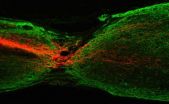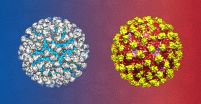The Lancet Respiratory Medicine: First trial of gene therapy for cystic fibrosis to show beneficial effect on lung function
2015-07-03
(Press-News.org) For the first time gene therapy for cystic fibrosis has shown a significant benefit in lung function compared with placebo, in a phase 2 randomised trial published in The Lancet Respiratory Medicine journal. The technique replaces the defective gene response for cystic fibrosis by using inhaled molecules of DNA to deliver a normal working copy of the gene to lung cells.
"Patients who received the gene therapy showed a significant, if modest, benefit in tests of lung function compared with the placebo group and there were no safety concerns," said senior author Professor Eric Alton from the National Heart and Lung Institute at Imperial College London. "Whilst the effect was inconsistent, with some patients responding better than others, the results are encouraging." [1]
Cystic fibrosis is a rare inherited disease caused by mutations in a single gene called cystic fibrosis transmembrane conductance regulator (CFTR) and affects 1 in every 2500 newborns in the UK and over 90000 people worldwide. Scientists have discovered around 2000 CFTR mutations so far. These mutations make the lining of the lungs secrete unusually thick mucus. This leads to recurrent life-threatening lung infections, which result in lung damage that causes 90% of deaths in people with cystic fibrosis.
Since the discovery of the genetic basis for cystic fibrosis in 1989, scientists have developed a variety of viral and non-viral vector systems for delivering a corrected CFTR gene back into lung cells. Despite expectations of a rapid breakthrough, no cystic fibrosis gene therapy trial so far has been able to show long-term clinical improvement.
Coordinated by the UK Cystic Fibrosis Gene Therapy Consortium [2], the two-year study involved 136 CF patients aged 12 years or older from across the UK. Participants were randomly assigned to either 5ml of nebulised (inhaled) pGM169/GL67A (gene therapy) or saline (placebo) at monthly intervals over 1 year. Lung function was evaluated using a common clinical measure of the volume of air forcibly exhaled in one second (FEV1).
After a year of treatment, in the 62 patients who received the gene therapy, FEV1 was 3.7% greater compared to placebo [3]. This was a result of stabilisation of respiratory function rather than an improvement. However, the effects were inconsistent, with some patients responding better than others. In particular, in the half of patients with the worst lung function at the start of the study, there was a doubling of the treatment effect, with changes in FEV1 of 6.4%.
Overall, the gene therapy was well tolerated and patients in the treatment and placebo groups experienced similar rates of adverse events.
According to senior co-author Professor Stephen Hyde from the Gene Medicine Research Group at the University of Oxford, "Stabilisation of lung disease in itself is a worthwhile goal. We are actively pursuing further studies of non-viral gene therapy looking at different doses and combinations with other treatments, and more efficient vectors." [1]
Senior co-author Dr Alastair Innes from Western General Hospital, Edinburgh, UK adds, "Publication of this trial is a landmark for cystic fibrosis patients and we are particularly grateful to the many patients across the UK who gave their time and effort to participate and make this collaborative venture a success." [1]
INFORMATION:
NOTES TO EDITORS:
This study was funded by a partnership between the UK Medical Research Council (MRC) and the National Institute for Health Research (NIHR).
[1] Quotes direct from authors and cannot be found in text of Article.
[2] The UK Cystic Fibrosis Gene Therapy Consortium is a group of scientists and clinicians from Imperial College London, the Universities of Oxford and Edinburgh, the Royal Brompton and Harefield NHS Foundation Trust and NHS Lothian who have worked together for over fifteen years to develop gene therapy for CF supported by the Cystic Fibrosis Trust http://www.cfgenetherapy.org.uk/index.php
[3] The 95% confidence interval for the effect size is 0.1% to 7.3%. Thus, although the best estimate of the effect size is 3.7%, the data are consistent with the true effect size lying anywhere in the range 0.1% to 7.3%. This interval straddles values from no effect to clear clinical relevance.
ELSE PRESS RELEASES FROM THIS DATE:
2015-07-02
LAWRENCE -- A new study that is the first to use Social Security Administration's personal income tax data tracking the same individuals over 20 years to measure individual lifetime earnings has confirmed significant long-term economic benefits of college education.
ChangHwan Kim, a University of Kansas researcher, said the research team was also able to account for shortcomings in previous studies by including factors such as gender, race, ethnicity, place of birth and high school performance that would influence a person's lifetime earnings and the probability of college ...
2015-07-02
DALLAS, July 2, 2015 -- An emergency room rapid response plan for children can help diagnose stroke symptoms quickly, according to new research in the American Heart Association journal Stroke.
"Just as there are rapid response processes for adults with a possible stroke, there should be a rapid response process for children with a possible stroke that includes expedited evaluation and imaging or rapid transfer to a medical center with pediatric stroke expertise," said Lori Jordan, M.D., Ph.D., study senior author and an assistant professor of pediatrics and neurology ...
2015-07-02
Researchers at the Hong Kong University of Science and Technology (HKUST) have found a way to stimulate the growth of axons, which may spell the dawn of a new beginning on chronic SCI treatments.
Chronic spinal cord injury (SCI) is a formidable hurdle that prevents a large number of injured axons from crossing the lesion, particularly the corticospinal tract (CST). Patients inflicted with SCI would often suffer a loss of mobility, paralysis, and interferes with activities of daily life dramatically. While physical therapy and rehabilitation would help the patients to ...
2015-07-02
Washington, D.C. - July 2, 2015 - Male fruit flies infected with the bacterium, Wolbachia, are less aggressive than those not infected, according to research published in the July Applied and Environmental Microbiology, a journal of the American Society for Microbiology. This is the first time bacteria have been shown to influence aggression, said corresponding author Jeremy C. Brownlie, PhD, Deputy Head, School of Natural Sciences, Griffith University, Brisbane, Australia.
The research began with a discovery by University of Arizona student Elizabeth Bondy, an undergraduate ...
2015-07-02
Astronomers are gearing up for high-energy fireworks coming in early 2018, when a stellar remnant the size of a city meets one of the brightest stars in our galaxy. The cosmic light show will occur when a pulsar discovered by NASA's Fermi Gamma-ray Space Telescope swings by its companion star. Scientists plan a global campaign to watch the event from radio wavelengths to the highest-energy gamma rays detectable.
The pulsar, known as J2032+4127 (J2032 for short), is the crushed core of a massive star that exploded as a supernova. It is a magnetized ball about 12 miles ...
2015-07-02
MINNEAPOLIS - A new study suggests that genes may not be to blame for the increased risk of heart disease some studies have shown in people with migraine, especially those with migraine with aura. The research is published during Headache/Migraine Awareness Month in the inaugural issue of the journal Neurology® Genetics, an open access, or free to the public, online-only, peer-reviewed journal from the American Academy of Neurology. Aura are sensations that come before the headache, often visual disturbances such as flashing lights.
"Surprisingly, when we looked ...
2015-07-02
BOSTON -- A new study led by scientists at Beth Israel Deaconess Medical Center (BIDMC) shows that an HIV-1 vaccine regimen, involving a viral vector boosted with a purified envelope protein, provided complete protection in half of the vaccinated non-human primates (NHPs) against a series of six repeated challenges with simian immunodeficiency virus (SIV), a virus similar to HIV that infects NHPs. These findings are published online today in Science.
Based on these pre-clinical data, the HIV-1 version of this vaccine regimen is now being evaluated in an ongoing Phase ...
2015-07-02
One more piece and we are done! A research team led by the Duke-NUS Graduate Medical School Singapore (Duke-NUS) has found the second-to-last piece of the puzzle needed to potentially cure or treat dengue. This is welcome news as the dengue virus infects about 400 million people worldwide annually, and there is currently no licensed vaccine available to treat it.
Associate Professor Shee-Mei Lok and Research Fellow Guntur Fibriansah, from the Duke-NUS Emerging Infectious Diseases (EID) Programme, led research that showed how an antibody neutralises dengue virus serotype ...
2015-07-02
In a new Science study, Duke-NUS Graduate Medical School Singapore (Duke-NUS) scientists have identified how small changes in dengue's viral genome can affect the virus' ability to manipulate human immune defences and spread more efficiently. This research is the first of its kind that examined the dengue virus starting from broad population level observations and then linked it to specific molecular interactions, to explain an outbreak. This work provides a framework for identifying genomic differences within the virus that are important for epidemic spread.
Dengue virus ...
2015-07-02
This news release is available in Japanese. Detailed tabletop experiments are helping researchers understand how Earth's landscapes erode to form networks of hills and valleys. The findings, which highlight a balance between processes that send sediments down hills and those that wash them out of valleys, might also help researchers predict how climate change could transform landscapes in the future. Kristin Sweeney and colleagues developed a laboratory device that mimicked the processes that smooth or disturb soil to make hillslopes, and those that cut it away to make ...
LAST 30 PRESS RELEASES:
[Press-News.org] The Lancet Respiratory Medicine: First trial of gene therapy for cystic fibrosis to show beneficial effect on lung function


